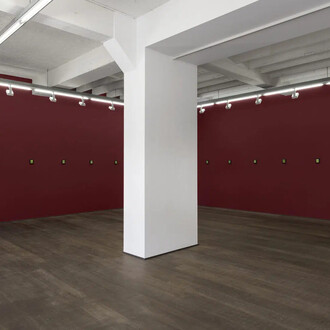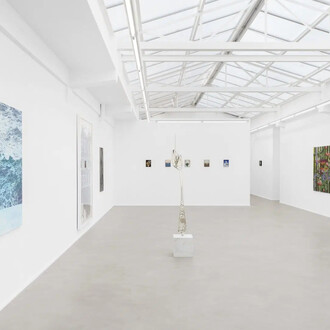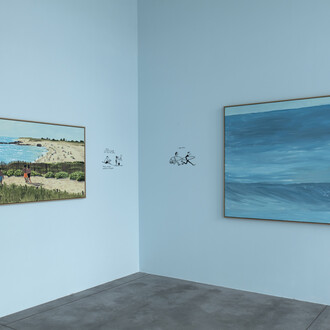For Joy & Rain, American artist Rachel Eulena Williams (b. 1991, Miami) presents a body of work that showcases the range and depth of her lyrical and hybrid practice. Operating on the threshold of painting and sculpture, Williams has developed a unique visual language. Hers is a quiet yet powerful subversion of long-held artistic conventions.
Understanding Williams’ artistic processes is a key to unlocking the multiple potential readings of her work. Regardless of format, everything begins with one basic material: rolls of untreated canvas and cotton. Williams handcolours the textiles using paints and fabric dyes before cutting them into disparate pieces. Through this action, the canvas is transformed from support to painterly medium. She then assembles the fragments into compositions that are glued, stitched and lashed together but also overpainted, with the final layer of pigment functioning as both a structural element and embellishment.
An observant viewer will notice that pieces cut from the same cloth appear across multiple works. While the initial catalyst for a work can often be traced back to one of Williams’ drawings, the act of making is largely intuitive and improvisational. Ropes, cords and threads of every description–thick, thin, slack, taut, knotted, frayed, natural or synthetic–are also integral to the assemblages. Their significance is twofold. On the one hand, they introduce a linearity that is akin to drawing, while on the other, they are the connecting threads–both literal and figurative–that bind the atomised shapes into an integral whole.
A powerful duality runs throughout Williams’ practice. It can be seen in the use of conventional materials to create works that both challenge and transcend genres; in the interplay between two- and three dimensions; in the contradiction between frugality and opulence (humble materials versus luminous colour); not to mention the tension between optimism and sorrow (the joy of bricolage versus the social implications of cotton and rope). While the tondo is a familiar form in Williams’ oeuvre, the new series in Joy & Rain points to multiple evolutions: the incorporation of open, negative space; the use of the raindrop motif as a recognisable and repeating form; and the flower-like clustering of the droplets to create a focal point from which the energy of the work radiates. Both the raindrop motif and exhibition title reference Melvonna Ballenger’s film Rain (Nyesha) (1978), a key source of inspiration for Williams. Charting a female journey towards self-awareness and empowerment, the video is a poetic meditation on the latent potency of rainy days. For Ballenger, the wet weather is less a metaphor for melancholy and more an opportunity for reflection, change and renewal. Williams also captures this atmosphere in the blue-toned colour palette and use of diluted, watery pigments.
The artist’s oeuvre can also be situated within the context of Black American artists’ contribution to modern art, with particular reference to pioneering women such as Betye Saar (b. 1927) or Howardena Pinnell (b. 1943). Williams’ unorthodox use of materials and techniques can thus be seen as part of the ongoing reframing of art history and general pivoting away from the heavy classical traditions of what a painting or sculpture can (or should) be. The emotive and connective power of colour is yet another touchstone. As art historian and curator Zoé Whitley writes: “I turn to the work of a number of Black women artists to be uplifted by their sublime use of rainbow-bright shades, not only for their evident beauty, but also for the unique ways in which they anchor their palette in our lived experience.” An experience that, in both historical and contemporary terms, is also reflected in the titles of the artworks (Strange Woman, American Fruit and Black and Blue, for example). Williams’ working methods also relate to practices centred around community and sustainability, such as recuperation, recycling, patchwork and sewing, and the dichotomy between supposedly ‘high’ and ‘low’ artistic endeavours. As the filtration device par excellence, and much like the creative process itself, it captures only what is essential and important.
Rachel Eulena Williams (b. 1991, Miami, Florida, USA) lives and works in Brooklyn, New York. She holds a BFA from Cooper Union for the Advancement of Science and Art, also in New York.
















